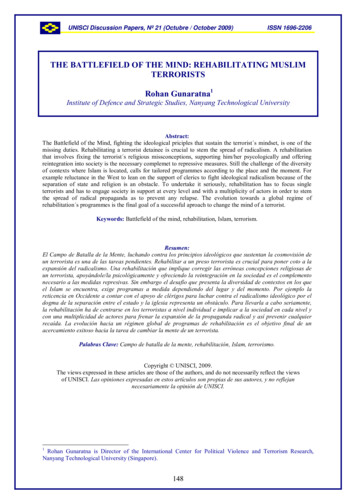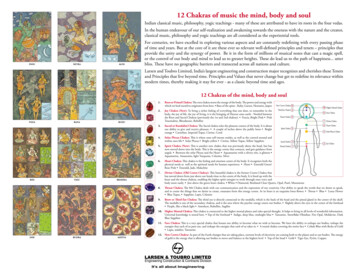
Transcription
UNISCI Discussion Papers, Nº 21 (Octubre / October 2009)ISSN 1696-2206THE BATTLEFIELD OF THE MIND: REHABILITATING MUSLIMTERRORISTSRohan Gunaratna1Institute of Defence and Strategic Studies, Nanyang Technological UniversityAbstract:The Battlefield of the Mind, fighting the ideological priciples that sustain the terrorist s mindset, is one of themissing duties. Rehabilitating a terrorist detainee is crucial to stem the spread of radicalism. A rehabilitationthat involves fixing the terrorist s religious missconceptions, supporting him/her psycologically and offeringreintegration into society is the necessary complemet to repressive measures. Still the challenge of the diversityof contexts where Islam is located, calls for tailored programmes according to the place and the moment. Forexample reluctance in the West to lean on the support of clerics to fight ideological radicalism because of theseparation of state and religion is an obstacle. To undertake it seriously, rehabilitation has to focus singleterrorists and has to engage society in support at every level and with a multiplicity of actors in order to stemthe spread of radical propaganda as to prevent any relapse. The evolution towards a global regime ofrehabilitation s programmes is the final goal of a successful aproach to change the mind of a terrorist.Keywords: Battlefield of the mind, rehabilitation, Islam, terrorism.Resumen:El Campo de Batalla de la Mente, luchando contra los principios ideológicos que sustentan la cosmovisión deun terrorista es una de las tareas pendientes. Rehabilitar a un preso terrorista es crucial para poner coto a laexpansión del radicalismo. Una rehabilitación que implique corregir las erróneas concepciones religiosas deun terrorista, apoyándole/la psicológicamente y ofreciendo la reintegración en la sociedad es el complementonecesario a las medidas represivas. Sin embargo el desafío que presenta la diversidad de contextos en los queel Islam se encuentra, exige programas a medida dependiendo del lugar y del momento. Por ejemplo lareticencia en Occidente a contar con el apoyo de clérigos para luchar contra el radicalismo ideológico por eldogma de la separación entre el estado y la iglesia representa un obstáculo. Para llevarla a cabo seriamente,la rehabilitación ha de centrarse en los terroristas a nivel individual e implicar a la sociedad en cada nivel ycon una multiplicidad de actores para frenar la expansión de la propaganda radical y así prevenir cualquierrecaída. La evolución hacia un régimen global de programas de rehabilitación es el objetivo final de unacercamiento exitoso hacia la tarea de cambiar la mente de un terrorista.Palabras Clave: Campo de batalla de la mente, rehabilitación, Islam, terrorismo.Copyright UNISCI, 2009.The views expressed in these articles are those of the authors, and do not necessarily reflect the viewsof UNISCI. Las opiniones expresadas en estos artículos son propias de sus autores, y no reflejannecesariamente la opinión de UNISCI.1Rohan Gunaratna is Director of the International Center for Political Violence and Terrorism Research,Nanyang Technological University (Singapore).148
UNISCI Discussion Papers, Nº 21 (Octubre / October 2009)ISSN 1696-22061. Introduction:Today, the most significant terrorist threat emanates from a global movement, underpinned bya violent politico-religious ideology. Political incompetence drives it, religiousmisinterpretation legitimizes it. Members of this movement seek to overturn regimes theyconsidered to be apostate through violent and undemocratic means. The local andinternational grievances of the Muslim masses are exploited to help construct a picture of ahostile modern world towards Islam and Muslims. The threat driven by a volatile ideologycan never be adequately addressed by military and law enforcement actions. A paradigm shiftmust occur.A terrorist suffers from exposure to terrorist propaganda and indoctrination. A viciousby-product of society, perhaps he was more susceptible and vulnerable to the terroristmessage than other members of the society. By skilfully approaching and interviewing, it ispossible to map the detainees’ ideological, theological, and intellectual makeup, orientationsand inclinations. After discerning the terrorist narrative that affected him to cross the line, thefactors that radicalized him to hate, conceive, plan, prepare, and attack can be identified. Tostrategically fight the contemporary wave of radicalization and violence, the understandingand knowledge rests within that terrorist. Rehabilitation allows communicating to thecaptured terrorist, allaying any misgivings he harbors. Such an approach will eventuallydefeat terrorism by decreasing the need for militaristic means.The battlefield of the mind is the neglected battlefield. A strategic investment, fightingthe battlefield of the mind is less costly. Extricating the negative feelings and replacing themwith positive thoughts is a more humanitarian approach. Making terrorist rehabilitationmandated by law will have other benefits. It will reduce humiliation, abuse and torture,routine in most detention facilities and penitentiaries in the developing world.2. Modes of Rehabilitation:Rehabilitation requires engaging the beneficiary on all its facets. A successful program mustrecognize all modes of rehabilitation. Within each mode of rehabilitation, there are variousstyles. The four principal modes of rehabilitation are: first, religious rehabilitation, second,psychological rehabilitation, third, social rehabilitation, and fourth, vocational rehabilitation.(1) Religious Rehabilitation: Every religion bring peace harmony and values tolerance.However, the ideas or religion or religious ideology has been used to provide justification forviolence. Although all the great religions teach us compassion, toleration and moderation,religion was misused in the process to convince people. In the past two decades we havewitnessed terrorism stemming by the propagation of deviant version of Hinduism, Judaism,Christianity, Buddhism, or Sikhism. Only the religious teachers and scholars can correct thisby replacing the wrong interpretation and wrong teachings. Many terrorists believe that theU.S. its allies and its friends are deliberately attacking Islam and killing Muslims. They aremade to believe that the West is the Satan and a religious obligation binds them to attack theU.S. its Allies and friends. Through the imposition of an extremist and militant interpretationof Islam, the terrorists are committed to re-establishing the Caliphate.149
UNISCI Discussion Papers, Nº 21 (Octubre / October 2009)ISSN 1696-2206To derive legitimacy for their struggle, they interpret the Qur’an in a manner thatportrays them as the true guardian of Islam. A learned Islamic scholar and a cleric have theunderstanding, knowledge and authority to correct the Islamic misconceptions a terroristbelieves to be true. Unfortunately, among religious community, the realization of the dangersof terrorism has not adequately touched them. Only the men of religion are adequatelyequipped to address this urgent issue. If the right formula is not applied, the terrorist messagewill spread to epidemic proportions. A systematic methodology is needed to bring themisguided back to the right fold path. Singapore’s Religious Rehabilitation Group producedtwo manuals in 2004 and in 2009 to aid religious counselling of Jemaah Islamiyah detaineesheld by the Internal Security Department (ISD), the security and intelligence service ofSingapore. In addition to imparting structured counseling sessions, the detainees are providedreligious texts to correct their misconceptions about Islam. In addition to the Koran, books onTfsir (exegesis of Koran) hadith (sayings and deeds of prophet), and Fiqh (jurisprudence) andSira (prophets history) are provided.2As wives were close to their husbands, the services of Ustazahs (female clerics) aremade available to counsel wives. In some cases, the husband tried to indoctrinate the wife andthe children with extremist beliefs and thoughts. As the husband went through a period ofexposure to deviant teachings, the wife must understand that husband has been propagatingwrong. In the future, the wife must neither propagate nor facilitate such views within thefamily. Some wives, especially those who attended similar classes were highly exposed.When husbands became very secretive, wives became confused with husband’s ideology andbehavior. As such, it is necessary for wives to be provided religious counseling. Althoughsome children as young as 14 were exposed, the preference is that they be counselled byfamily.3 To prevent this vicious cycle, mothers are counseled with the hope that theyunderstand their mistake and guide the children to follow the correct principles.4Through a combination of tools, a terrorist who need help can be reformed. Whilepsychological, vocational, and social and family rehabilitation can change ones heart andmind, the most powerful is religious rehabilitation. Religious rehabilitation has the power tounlock the mind of a detainee or an inmate. It has the power to make a beneficiary ofrehabilitation repent, become remorseful and re-enter the mainstream.(2) Psychological rehabilitation: The psychologist adds an important dimension to therehabilitation process. Psychology enables to understand why some cross the line and kill.The methodology involves psycho profiling, assessment and solution. From a psychologicalperspective, it is much easier to change behavior with rewards than with punishment.Introducing a carrot to accompany the many sticks we have, to reform terrorists may be lesscostly than to omit it out rightly. By showing terrorists that they can benefit from bothdenouncing a violent ideology and from becoming more socially accepted, will remove theirreason to fight. Unless a major crime had been committed, their violence must not solely be2Interview with Ustaz Mohamed bin Ali, former Secretary, Religious Rehabilitation Group, and AssociateResearch Fellow, International Centre for Political Violence and Terrorism Research, S. Rajaratnam School ofInternational Studies, Nanyang Technological University, Singapore, February 22, 2009.3After coming to know of the father’s arrest, his indoctrinated son said: “Dadda, you terrorist! Very good dada.”As the son believed the father to be fighting the U.S., its allies and friends, the father was his personal hero.Interview with senior government official, July 2008.4Ustaz bin Ali, Mohamed: “Striking the Roots o Radicalism, Reclaiming Islam’s Intellectual Heritage”, inHalim bin Kader, Abdul (ed.) (2009): Countering Radicalism: The Next Generation and Challenges Ahead,Singapore, Taman Bacaan, pp. 107-112.150
UNISCI Discussion Papers, Nº 21 (Octubre / October 2009)ISSN 1696-2206met with punishment in the form of prolong imprisonment or detention as this may increasetheir rage and sense of social alienation.5 For others, it could be misconstrued as injustice.This leaves humankind with an obligation; a duty compelling immediate attention. Thecaptured terrorists must be convinced that their imprisonment or detention is to allow them toparticipate in a rehabilitation program. They must be assured of getting all the help they needto understand where they went wrong and how to avoid falling into the same behaviorpatterns that trapped them in the first place. For this, they must be given access to enter intodialogues with qualified clerics and scholars of Islam. Their genuine concern for the sufferingof Muslims in places such as Gaza and the West Bank, Iraq and Afghanistan must not bequickly dismissed as extremism. On the contrary, it should be considered as a window thatcan provide greater understanding on how their minds work. This will present the counselorswith the opportunity to strengthen the poor reasoning capacity and poor communication skillsmost of them are known to have. Whenever they manifest emotional attachment to a certainissue, counselors must help them develop a positive attitude to deal with the issue and seizethe opportunity to diminish extremist thought and behavior. With all these benefits,rehabilitation becomes not a choice but a must.(3) Social Rehabilitation: When the head of a family is detained, he ceases to be thebreadwinner of the family. Often the head of the family is the only breadwinner. As thefamily starts to suffer, both the wife and the children need assistance to survive. Socialrehabilitation becomes essential because the family is traumatized by the detention. Socialrehabilitation addresses the concern of the family. The means of livelihood for the family, theneed for school for the children, and making sure the wife and children and have a roof overtheir head. Then family rehabilitation becomes a part of social rehabilitation. They shouldreceive community assistance to carry on with their lives.As a part of the community aftercare initiative, the wives should be visited bycommunity and social workers. Children should not be socially isolated and treated as ifeveryone in the family is a terrorist. It becomes necessary to take care of children in a waywhere the children do not form the next generation of terrorists. By preventing isolation andtrauma, the family’s reintegrated back to society is facilitated.As a part of the social rehabilitation, social workers assigned to the program gave thechildren toys and helped them with school. When the images of the father were published inthe newspaper, a child was ridiculed that the father was a communist.6 The community andsocial workers arranged for the child to be transferred to another school.7 To give themstrength to live, the community and social workers regularly visit and motivate them.Mentally and otherwise engaging them, prevent anger and resentment. Otherwise, it wouldcreate the opportunity for extremists and extremist groups to reach out to them. To denybitterness and counter extremism, community and social workers provide aftercare by way ofjobs, monetary assistance, and a fresh outlook. By the time the detainee is released, the familyis also transformed. Even after release, community and social workers should continue towork with the family.5Conversation with Ustaz Mahfuh Halimi, International Centre for Political Violence and Terrorism Research,S. Rajaratnam School of International Studies, Nanyang Technological University, Singapore, February 22,2009.6Halim Kadir, President Taman Bacaan, Singapore, Question and Answer Session, Panel on SingaporeExperience, International Conference on Terrorist Rehabilitation, February 26, 2009.7Ibid.151
UNISCI Discussion Papers, Nº 21 (Octubre / October 2009)ISSN 1696-2206(4) Vocational Rehabilitation: To reintegrate the detainees and inmates back to society, theyneed to be guided and prepared through skills development and educational attainment.Designed to provide necessary skills for a job, vocational rehabilitation imparts skills usefulto detainees and inmates upon release. This ranges from teaching them metal and wood work,carpentry and masonry, dairy farming and agriculture, computer and language skills and selfstudy and distance education. Unlike the other modes of rehabilitation, vocation rehabilitationruns a security risk. To minimize the risk, detainees and inmates are not taught certain skillssuch as electronics, a capability that could be used to build circuitry for bombs. More than inany other country, under the careful guidance of Major General Douglas Stone, vocationalrehabilitation was developed in Iraq to an unprecedented level. Working with OSS, a U.S.Department of Defence contractor specializing in rehabilitation, and the International Centrefor Political Violence and Terrorism Research in Singapore, Dr. Stone’s vision and mission,created renowned resident expertise.8 After release, “Picasso,” a former Al Qaeda in Iraqdetainee with a talent for art was recruited by OSS to teach art.9 A master theoretician andpractitioner of rehabilitation, Dr. Stone built a wide ranging program in Iraq that governmentsinterested to create rehabilitation programs continues to benefit. Coupled with vocationalrehabilitation, the integration of art, dance, song, and other cultural expressions into therehabilitation package broadened the horizons of the detainees. The Kingdom of Saudi Arabiaestablished a care centre in a suburb of Riyadh with games, cooking, and the study of arts. Abeneficiary of the centre, Mohammed Dousery, a Guantanamo detainee for six years, said:“The centre prepared me to engage gradually with the rest of society; ‘You can’t go directlyfrom Guantanamo bay to normal life. This is an extremely difficult thing, and everythingchanges, Saudi changes and so does the rest of the world. I have a great wife, and she isencouraging me to try and forget Guantanamo and she says to me; forget that prison, you area new man and you have a new life in front of you and you have your family. Focus yourconcerns on this. This makes me feel much better.’10 The five compounds, each with acapacity for 1200 people, support reintegration back to Saudi society. The beneficiaries, asthey are called, are able to swim, play football, table tennis, and TV-games. In an airconditioned tent converted into a dining hall serve traditional food where they engage indialogue. In vocational rehabilitation, as in other modes, the range of activities is only limitedby human imagination.3. Working Model:There are practical difficulties of developing a universal model to rehabilitate terroristsseeking to justify their actions through Islam. To start with, Islam comes to every country indifferent ways. As such, there is a need to understand diverse values and traditions of the8After assessing the degrees of radicalization of detainees at Camp Cropper, Singapore delegation trained U.S.and Iraqi personnel on how to build a rehabilitation program in Baghdad in December 2007, and thereafterworked with OSS to build the religious rehabilitation manual and counseling guide. Singapore’s assistance tobuild a rehabilitation program in Iraq was classified until it was publicly acknowledged both by General Stone,the former Deputy Commanding General in Iraq responsible for detainee rehabilitation, and the Singaporedelegates at the inaugural International Conference on Terrorist Rehabilitation in February 2009.9Stone, who assumed duties in mid-2008 was impressed by the art program for detainees in Saudi Arabia. Headapted it in Iraq with the assistance of Dr. Ami M. Angell of OSS.10“Special centre for rehabilitation of deviating groups in Saudi Arabia”, Al-Jazeera, July 9, 2008, athttp://www.al-jazirah.com.sa/277512/ua1d.html .152
UNISCI Discussion Papers, Nº 21 (Octubre / October 2009)ISSN 1696-2206Muslim community – how they practice Islam, how they relate to each others, and how theysee the world. The economic context, political environment, and unique language and culturemake standardization a challenge. As the security landscape in every country is different, theterrorists are also different. As the conditions of capture, treatment during incarceration, andrelease differ, there will never be one standard rehabilitation program. A government candevelop a standard model but it will be applicable to a specific threat group at a specific placeand time. Every rehabilitation program operates in a community context. Although criminaljustice and prisons systems are unique to different countries, an approach to rehabilitationmust exist. Instead of a standard model, a working model on rehabilitation should consider anumber of essential aspects.First, those selected to undergo rehabilitation should be viewed as a beneficiary and nolonger as an inmate or detainee. Most security prisoners and detainees are treated poorly, attimes harassed, and even tortured. Most guards have a pre-conceived notion of detainees andinmates that lead them to act aggressively towards them. In a testimony, Brandon Neely, aU.S. soldier assigned to Guantanamo Bay said: “We would be coming face to face wit theworst people the world had to offer.”11 As most penitentiaries and detention centres have norehabilitation space, the potential beneficiaries should be relocated to a facility that mirrorsociety. As the beneficiary is to be released back to society, he should no longer be isolatedbut engaged. To build understanding and create a channel for peaceful articulation ofdifferences, an environment conducive for dialogue with the beneficiary should be created.Second, rehabilitation should begin on day one of arrest. If the captured terrorist isbeaten, he is likely to harbour a grudge at least remember the treatment meted out to him onday one. Even the best form of interview with a detainee is rapport based. Threats and tortureis unlikely to yield truthful information. Rehabilitation is a painstaking process that requirespatience, dedication and reflection. It requires finding and matching the right counsellor withthe beneficiary. For instance, a Shia cleric will not be able to rehabilitate a Sunni beneficiary.The moment, the cleric walks in the beneficiary will think that Satan has arrived. To ensuresuccessful reintegration back to society, rehabilitation should be continuous duringincarceration and upon release to the family and community leaders.Third, rehabilitation is a collective effort not only by investigative officers andoperations officers but by the clergy and the academia. Although it involves different interestgroups working together, the most crucial is the public-private partnership between thesecurity and intelligence service and the clergy. It is paramount to build a lasting relationshipbetween the government holding the detainees and inmates and the clerics and scholarscommitted to protecting their faith from misinterpretation and misrepresentation. Unlessgovernment and clergy work together, the most crucial platform, the rehabilitation programwill fall apart. The most crucial platform built for rehabilitation can be eventually expanded toengage the Muslim community.Fourth, as religious justification was used to bring about the terrorist mind into theconcept of hate and violence, counselling by clergy should be an essential part of the program.In the West, where church and state are separate, there is a reluctance to use religiouscounsellors. By neglecting this crucial dimension, other modes of rehabilitation are unlikelyto work. Government should cast aside their suspicions and find a channel to betterunderstand and work with the clerics. Gradually, the clergy themselves must be made towitness what terrorism has done to individuals. The clergy should decide for themselves that11Testimony of Spc. Brandon Neely, Guantanamo Testimonial Project, December 4, 2008.153
UNISCI Discussion Papers, Nº 21 (Octubre / October 2009)ISSN 1696-2206the terrorists are wayward from the right Islamic teachings. When it becomes apparent that afew minorities are casting a bad image on the religion, there will be many clergy volunteeringto protect Islam. Then working with terrorists becomes the responsibility of clergy keen touphold the dignity of the religion itself. The members of the clergy must be careful not toproject his own school or orientation as the right interpretation of Islam. That will lead todiscord between the clergy. Clerics from the diverse schools and orientations should joinhands and work together to fight a common threat.12Fifth, successful rehabilitation requires the continuous study of the evolving terroristnarrative and ideology as well as their perceived and real grievances and aspirations. Itrequires access to studies by other programs and institutions. The terrorists and theirsupporters thought that they can help Muslim brothers by doing “jihad” in Somalia, Iraq,Afghanistan, Pakistan, Palestine, Chechnya, Thailand, Indonesia and the Philippines. Theclerics and scholars should develop an intellectual capacity to rebut the ideology and deliveran Islamic alternative to traveling and fighting in conflict zones. The response should be arebuttle to correct the deviation, that jihad permits killing non-Muslims.13 Instead, analternative can be proposed to support the humanitarian work in Gaza and Kashmir. Energyand resources can be committed to work peacefully to rebuild the lives and property of thosewho have suffered in conflict zones.Sixth, constant training and education of the professional and support staff at therehabilitation centre is essential. Whether it is a guard or a sports instructor, no one should beassigned to the rehabilitation centre without undergoing an orientation course. Evenmomentarily, if a guard on duty ill-treats a beneficiary, the goodwill built by others will bedamaged.14 There is no standard text book to rehabilitate a terrorist. As terrorist rehabilitationis a new discipline, it is necessary to nurture a culture of research where a specialist team willconstantly learn, develop and refine the existing understanding and knowledge.15 Terroristrehabilitation is neither an exact science nor a romance. Rehabilitation is both a science andan art. As such a rehabilitation centre should never be run by a bureaucrat but by a dynamicleader. As beneficiaries differ from another, it requires creative leadership, not classicalbureaucracy at work. It is essential to evaluate successes and failures and maximise successesand minimise failures.Seventh, trained and dedicated expert staff is needed to classify and profile thedetainee and inmates. Before selection as a beneficiary of the rehabilitation program, it isnecessary to assess if the terrorist is a high, medium, or low risk as well as to profile hiseducation, family, the depth of his operational involvement and ideological commitment.Both his involvement and ideology is not dependent on his level of education (low, medium12There is a maxim in the Islamic law stating that if you busy yourself with something which is not theobjective, it is the same like turning away from the objective. Conversation with Ustaz Mahfuh Halimi, March10, 2008.13From the Medina charter to the Alliance of Excellence [hilf al-fudul], Islam has promoted peace betweenMuslims and non Muslims. For instance, when Ali, the fourth Caliph was asked the relationship between aMuslim and a Muslim, he said, “we are brothers in faith.” When asked for the relationship between Muslims andnon Muslim, Ali answered, “we are brothers in humanity.” Conversation with Ustaz Mahfuh Halimi, March 10,2008 Also visit: Muslims United Against Humanity, at http://www.muat.co.uk/islam.asp .14The Governor of Helmand Province in Afghanistan, Mullah Abdul Salam Zaeef, the former TalibanAmbassador to Pakistan, spent three years at Guantanamo Bay. In his book titled “Da Guantanamo Anzoor”, headmires a few Americans who were nice to him, did not torture or beat him, and spoke to him kindly. Seewebpage: http://www.cageprisoners.com/print.php?id 28123 .15The motto of RRG is “Loving, Caring and Sharing. See: Khadijah Mosque (2008): Winning Hearts andMinds, Embracing Peace, Singapore, Khadijah Mosque, p. 1.154
UNISCI Discussion Papers, Nº 21 (Octubre / October 2009)ISSN 1696-2206or high) but the degree of his exposure. Even the most educated are susceptible to the messageof a charismatic preacher: “By doing jihad, we can go to paradise.” Like love, ideologymakes terrorists and supporters blind. As the degrees of indoctrination and commitmentdiffer, government experts together with clerics and scholars should work on a structuredprogram and a tailored syllabus for each of the beneficiaries. Otherwise the message will notreach the beneficiary and the investment will be wasted.Eighth, resources are needed to create an environment conducive for counselling. Asmost detention and penitentiary facilities are over crowded and conditions are exceptionallypoor, the environment is not conducive for rehabilitation. As such governments should investresources to construct new facilities or relocate the beneficiaries to appropriate facilities. Asopposed to mass and group counseling, one-to-one counseling will involve a dialogue in acomfortable room.16 Seated on a sofa, the preacher and the beneficiary will sit sipping tea, eatdates, listen to each other and discuss matters of interest from God to the Koran and Islam toMuslims. If it is mass counselling, it is necessary to determine the target audience. It isnecessary to structure the message by looking at who we want to talk to and what we want totalk about. There should be continuous assessment of the beneficiary/beneficiaries to assesshow well he is responding to counseling.Ninth, no rehabilitation program will achieve its desired impact unless governmentworks to counter the extremism dormant in the community. While the reverse ofradicalization in custody is rehabilitation, the reverse of radicalization outside detention iscommunity engagement. Ideally, the blue print for winning hearts and minds should comefrom debriefing and deprogramming detainees. Terrorist rehabilitation holds the key toinoculating communities against the contemporary wave of extremism and terrorism.During rehabilitation, the counselors can elicit from the beneficiary the content tocounter terrorist propaganda targeting and affecting the community. As the terrorist in custodyportrays both the problem and solution, the detainee needs to be managed and handled to beuseful to cure the others in the community who are also affected but undetected.Tenth, no one can give a guarantee that a person’s mindset can be changed throughrehabilitation. To ensure he will not become a contaminant upon release, it is necessary tosupport his gradual reintegration into society. Even before final release, the beneficiary shouldbe placed in a half way house where he can spend time with his family and friends and remaincommitted to peace. To prevent rejuvenation of extremist ideas and thou
The battlefield of the mind is the neglected battlefield. A strategic investment, fighting the battlefield of the mind is less costly. Extricating the negative feelings and replacing them with positive thoughts is a more humanitarian approach. Making terrorist











